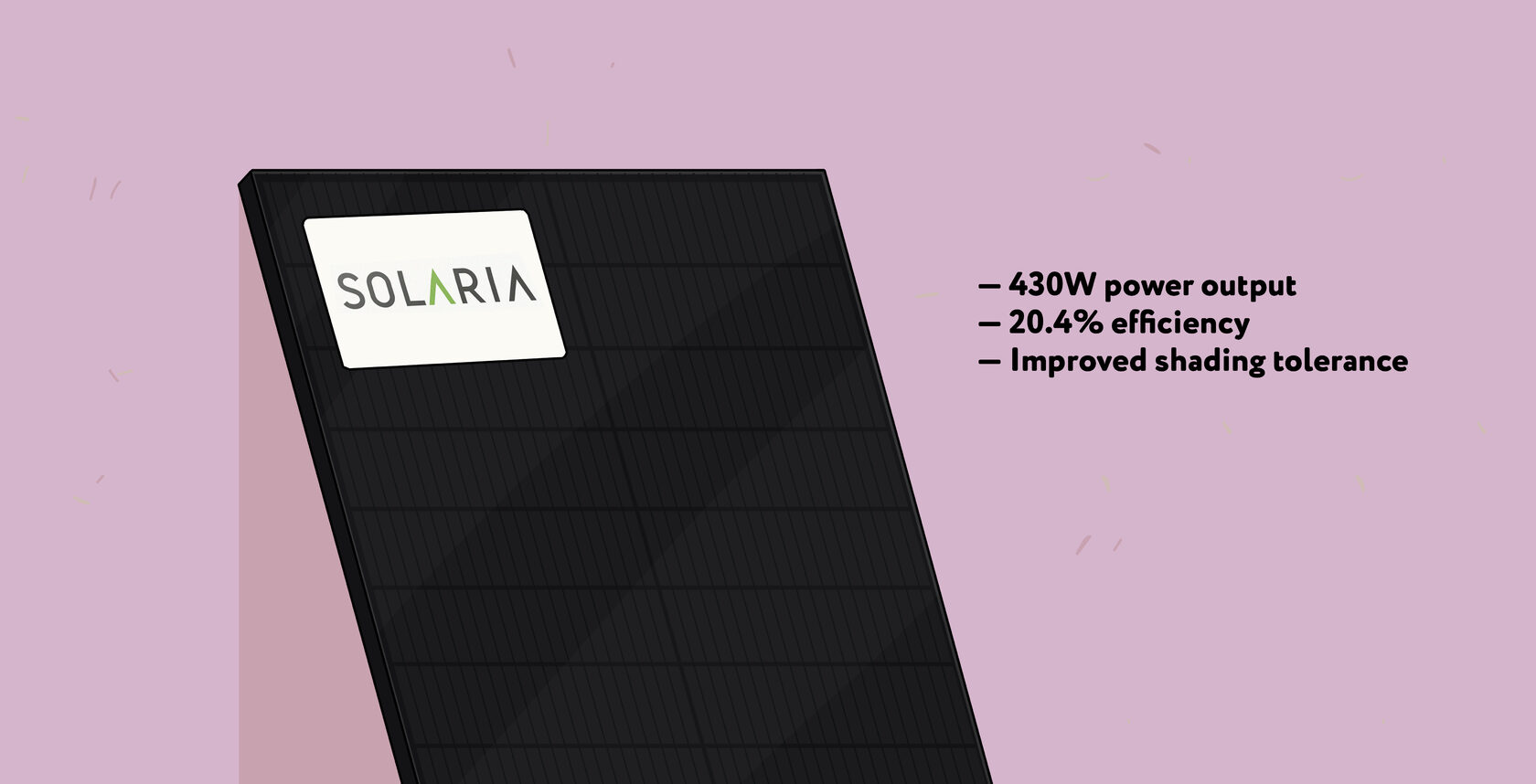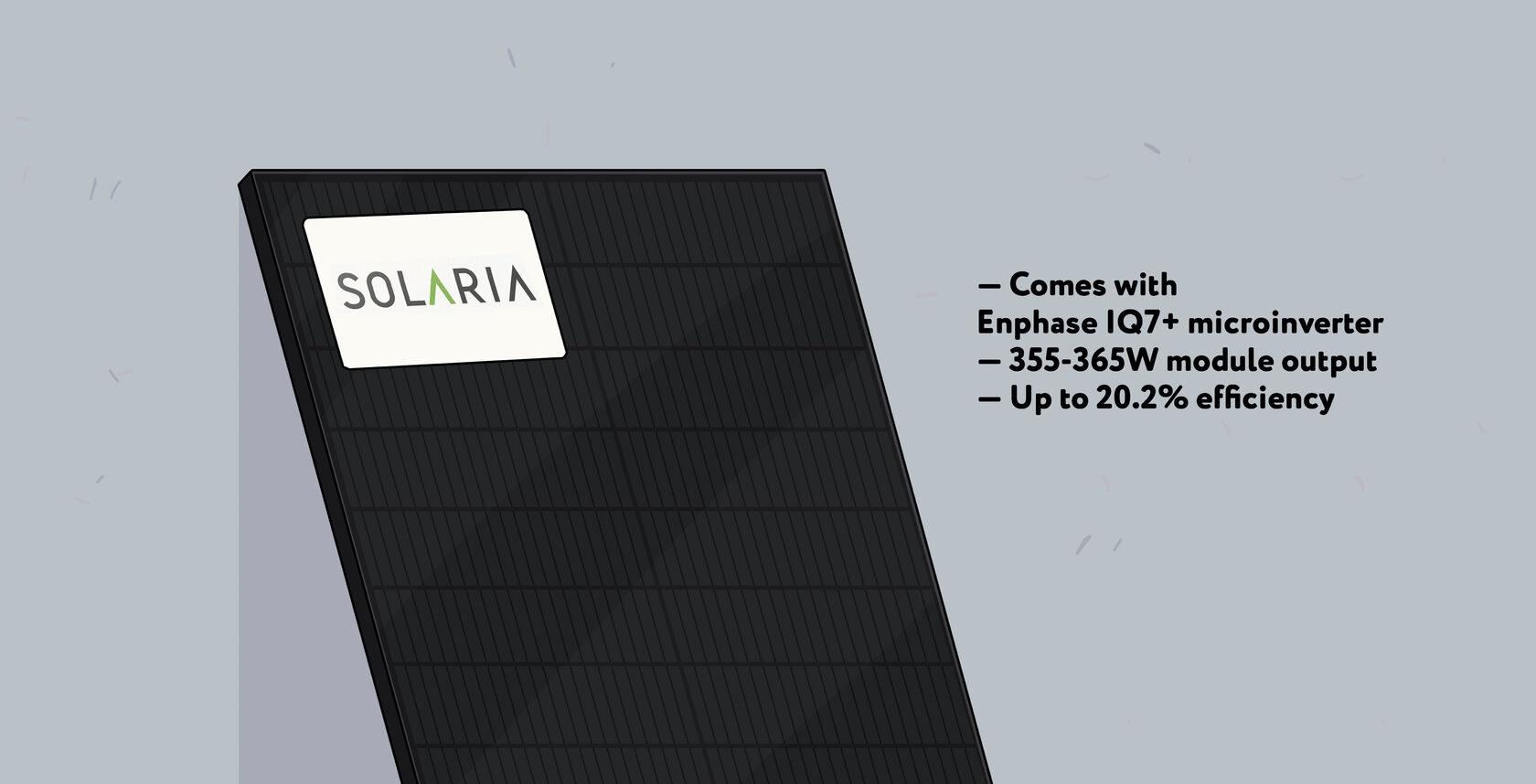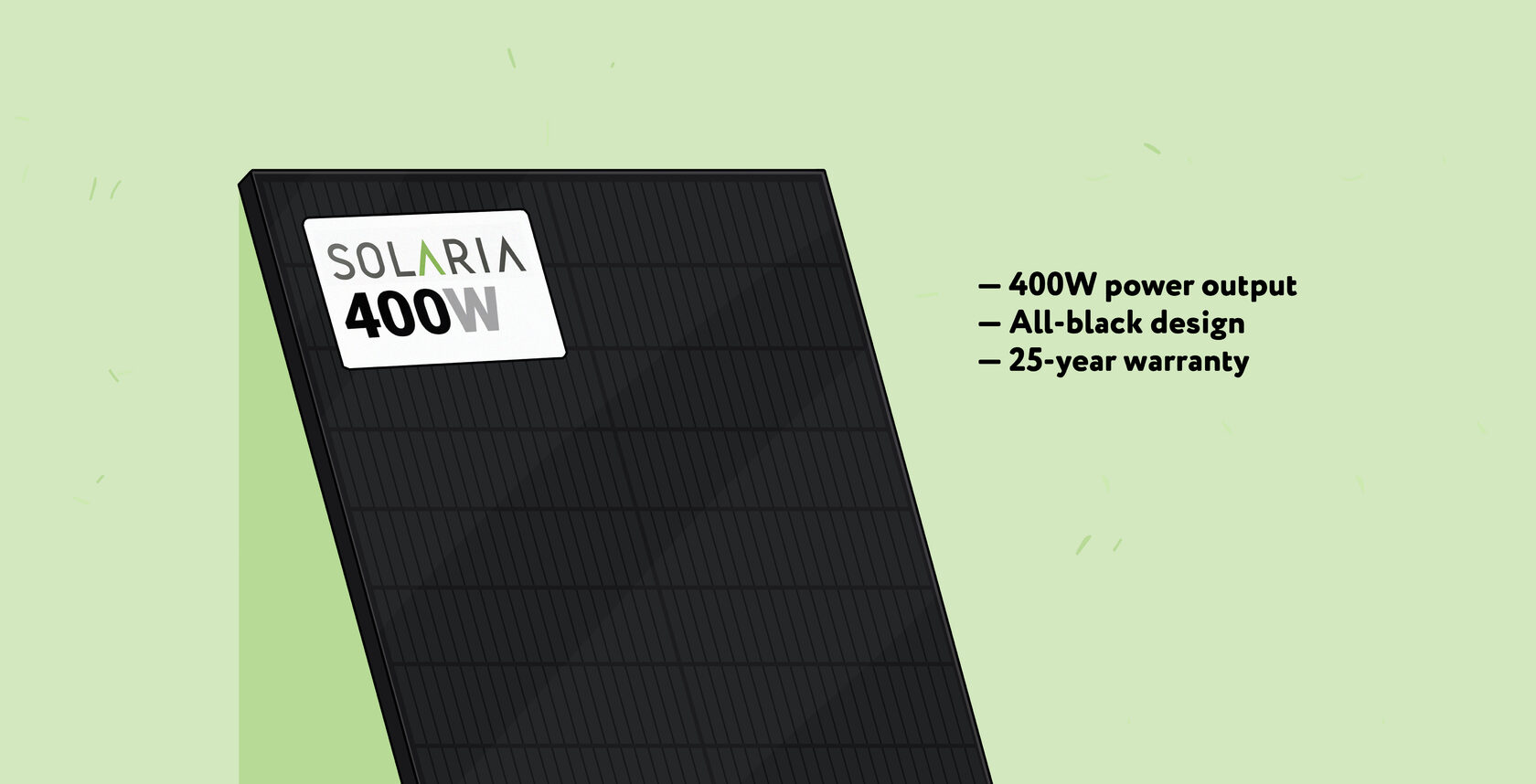If solar manufacturers would hold a beauty contest among their panels, Solaria could take the first prize. The looks and the high price of modules from this American manufacturer certainly leave an impression. It’s not just for the show. American engineers have devised their own design which makes their PV modules special in many different ways. Let’s examine these ways closely in our Solaria solar panels review.
Solaria is a leader in shingled solar cell design

What makes Solaria solar panels so different from others is their approach to photovoltaic cells. American engineers slice solar cells into 5-6 strips and these strips are overlaid to create an electrical connection between them. It’s a bit like laying shingles on a roof. As a result, a shingled solar panel doesn’t need busbars, thin copper ribbons or wires that usually connect solar cells together in a module. Without busbars, a panel gets a much more uniform look which makes it more appealing to an eye.
Busbars, however thin they are, also take up the surface of a panel – the area that is covered by a busbar doesn’t produce energy. The shingled design allows to cover all the available surface with solar elements without the need of spacing cells apart as in panels of a traditional design. More active surface means a bigger energy harvest from a square foot.

The fact that a PV module doesn’t have busbars also makes it more reliable since busbar failures are excluded. Solar shingles are glued together with a conductive adhesive and overall a shingled solar panel is even more resistant to mechanical pressure than a standard PV module.
Another advantage of a shingled design is higher shading tolerance. Solar cells in a normal panel are connected in series which means that the performance of one cell depends on its neighbors and so on. Shingled sub-strings in Solaria panels are connected in parallel which makes them independent from nearby strings. In general, Solaria panels are 37-45% better at fighting shading than traditional panels.
Don’t confuse shingled solar panels with solar shingles! Solar shingles are a special type of panels that are made to look and function like roofing materials.

Description
At the end of the day, the advantages of shingled solar panel design include:
• better aesthetics;
• higher energy production from a square foot;
• improved shading tolerance;
• higher reliability.
Higher manufacturing costs and a large number of required intellectual property explain Solaria solar panels prices and why most companies abstain from shingled design. Solaria isn’t the only brand that has been using it, though. Sunpower and Seraphim Solar also try out designs based on the same idea. However, Solaria can be considered the pioneer of the technology and certainly remains its leader.
Solaria sold its patents for shingled solar cells to Maxeon in 2023. Will Anderson, CEO of Complete Solaria, stated the company shifts from pure manufacturing of solar panels to a ‘total-service model’ in which Solaria designs, installs, and warrants full solar systems.
Solaria solar panels: Quality comes at a price
19%-21%
average efficiency
Solaria panels show good efficiency that ranges from 19.6% to 20.5%, which is higher than average numbers on the market. Shingled design allows engineers to maximize the active area of a panel. Higher power output per square foot allows you to make a system that matches your needs with less panels and less space than with most manufacturers.
$1–$1.3
per Watt
Solaria panels come at relatively high price due to the use of the shingled design. The cost per watt ranges from $1 to $1.3 or higher. That puts the American manufacturer in the upper part of the list of brands with the most expensive panels. While Sunpower or LG panels can be more expensive, Solaria is right behind them next to Panasonic and REC.
Solaria offers a 25-year warranty for parts, performance and labor which is on par with top-tier manufacturers like REC and Panasonic in that regard. Solaria panels retain 86% of their power output after 25 years in service which is slightly better than average degradation rates in the industry. The reliability of Solaria panels is proven by a number of quality certificates, like TUV Rheinland and RETC, and the brand is recognized as a ‘Top performer’ in DNV GL PV Module Reliability Scorecard.
When it comes to harsh weather tolerance, Solaria is on top of its game. Solar cells are protected by a black anodized aluminum frame and a layer of tempered glass. The modules can withstand 5400 Pa of pressure on the front side which is enough to survive tornadoes and hurricanes of small and medium scale. Shingled design increases the overall durability of a module.
Great shading tolerance of Solaria modules is not to be overlooked. Sub-strings inside a panel are connected in parallel instead of the traditional connection in series. Each panel has four bypass diodes which split the module into four independent sections. Overall, Solaria panels lose around 40% less energy caused by shading than standard panels.
Solaria solar panels: Pros
Let’s pass on to the advantages and disadvantages of Solaria panels. First, let’s look at what’s really good about them:
• Outstanding appearance. Shingled solar panels don’t have busbars therefore their look is much more uniform.
• Great power output. Modern design increases the power density of Solaria modules. You’ll need less space and fewer panels to build a powerful system than with most manufacturers.
• Improved shading tolerance. Sub-strings of Solaria panels are connected in parallel which lowers losses caused by shading. Overall, Solaria panels perform 40% better than standard panels during shading tests.
• High reliability. Solaria products are known to be high quality which is proven by a number of international certificates. The innovative design of their modules lowers the failure risk of a module.
• Great warranties. Solaria panels come with a 25-year warranty for parts, performance and labor.
Solaria solar panels: Cons
A very impressive list of advantages! But about the cons of the Solaria product? Here they are:
• High price. Shingled solar panels are more expensive to make and require the most qualified engineers. As a result, Solaria panels came at $1–1.3 per watt.
• A PV system might be more difficult to troubleshoot and repair. Shingled solar panels aren’t all that common. Therefore if troubles occur, not every engineer can fix them. However, the higher reliability of shingled panels and the quality standards of Solaria lower the risk of having to call for service.
• Relatively small product line. Solaria panels are designed primarily for building residential systems. There are simply no high-output modules for projects of a greater scale in the product line of the American manufacturer.
Solaria solar panels overview: For home and business
Having said so many good things about shingled solar panels, we’re itching to take a look at the actual modules from Solaria. As usual, we’ve asked our engineer to evaluate three models and share his opinion.

The first thing that stands out with Solaria panels is the fact that none of Solaria panels have a number of cells in their descriptions. The fact that Solaria engineers moved away from the traditional concept of a solar cell explains it. Notice however that Solaria panels are a little different in size than standard 60 and 72-cell panels which certainly plays its role when you are planning an installation.
Solaria PowerXT-360R-PD – Stylish choice for your home

PowerXT-360R is what you would call a standard choice for a residential PV system from Solaria. However, this panel is shorter and a little wider than a standard 60-cell panel — 63.8" x 43.9" whereas the size of a normal home panel is closer to 66" x 39". All-black design and no visible busbars make the panel look exceptional on any roof. Shingled design provides great shading resistance. The module itself is durable enough to withstand any harsh weather that is coming your way.
Solaria PowerXT 430R-PL – Impressive business solution

This panel from Solaria is a good choice for home and commercial projects of small and medium scale. It is the most powerful module in the product line for now. Amazing design of these modules catches an eye and contributes to the image of your business. The panel is split into four sections and parallel connection of substrings ensure low energy losses due shading. It is well protected from harsh weather conditions and potential induced degradation. The module comes with a 25-year warranty for parts, labor and power output.
Solaria PowerXT-365R-AC – Easy setup

PowerXT-365R-AC is an AC module which means that the panel comes with a preinstalled microinverter. The installation is much simpler with these modules – you just plug them into your electric panel and there is no need for a separate inverter. Enphase IQ7+ provides 290W of continuous power with 97.5% efficiency and can be managed remotely. While an AC module is a bit more expensive, it is a good choice if you want to simplify the installation process.
A1 SolarStore recommends Solaria PowerXT-400R-PM

We strongly recommend PowerXT-400R-PM which is suitable for both residential and commercial installations. The panel provides great power output with 20.2% efficiency. After 25 years the module retains 86% of initial output. The panel is well prepared for extreme weather conditions and shows great shading tolerance. Notice the unconventional size: most 72-cell panels would be around 39" x 77" in dimensions, Solaria panel is instead wider: 47" x 64".
A1 SolarStore verdict: Solaria panels are worth it in many ways
We’ve examined the specific design of Solaria panels, their cost, efficiency, resiliency and warranties. We’ve looked at pros and cons and several models from the brand. It’s time to sum it all up in a short list:
• Solaria is an American brand with 20 years of experience on the market.
• It makes panels primarily for residential and commercial projects of small and medium scale.
• It is a leader in shingled solar panel design technology.
• Shingled solar panels are prettier, sturdier, have better shading tolerance and higher power density, but they are expensive to make.
• The cost of Solaria panels is quite high: from $1 per Watt and higher.
• Solaria panels are more efficient than average: 19.6%-20.5%.
• Their panels are very high quality and come with a 25-year warranty for parts, labor and performance.
• They have an outstanding shading tolerance, losing 40% less than standard panels.
• Solaria panels are simply beautiful: the all-black modules with a smooth uniform surface are really an eye-catcher.
The innovative design that Solaria brings to the table is not only about making your house or office building stand out. Shingled panels are worth it in many ways. Therefore we can only strongly recommend Solaria PV modules. If you have the means, go for them and they will serve you diligently for years and years. With that we end our 2024 Solaria solar panel review – stay tuned for more.
Article updated in summer 2024
Compare Solaria to other popular brands:
☀️ LG Solar panels vs Solaria: comparison
☀️ REC solar panels vs Solaria
☀️ Trina solar panels vs Solaria
☀️ Panasonic solar panels vs Solaria
☀️ Silfab solar panels vs Solaria
Illustrations – Marina Fionova




 SunPower solar panels review 2025: Maximum efficiency
SunPower solar panels review 2025: Maximum efficiency REC solar panels review 2025: Premium-class solar
REC solar panels review 2025: Premium-class solar




